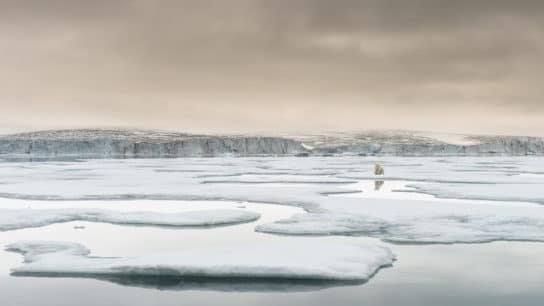This weekly round-up brings you key climate news from the past seven days, including findings from the United Nation’s latest State of the Global Climate report.
—
1. Record Sea Levels, Ocean Heat, CO2 Concentrations in 2024 a ‘Wake-Up Call’ For Humanity, Warns UN Weather Agency
Highest atmospheric concentrations of carbon dioxide in 800,000 years, record ocean heat content and sea levels and lowest Arctic sea-ice extents. This is the grim picture emerging from the World Meteorological Organization’s (WMO) new State of the Global Climate report, which looked at changes in climate trends over the course of 2024, the hottest year on record.
These “distress signals” are “clear signs” of the impacts of human activities on our climate and environment, with some consequences deemed “irreversible over hundreds if not thousands of years,” the report concluded.
Atmospheric concentrations of all three major planet-warming greenhouse gases – carbon dioxide (CO2), methane, and nitrous oxide – reached new highs in 2024, the report confirmed.
Each of the past eight years has set a new record for ocean heat content, according to the report, with 2024 seeing the highest level in the 65-year observational record. It also added that the rate of ocean warming over the past two decades (2005-2024) is more than twice that in the period 1960-2005.
The global mean sea level also reached its peak since satellite recordings began in 1993, rising at twice the rate between 2015 and 2024 compared to the 1993-2002 period, from 2.1 mm annually to 4.7 mm per year.
2. Glaciers Once Deemed ‘Eternal’ Will Not Survive 21st Century, Warns UN
Glaciers are disappearing at an alarming rate, with five of the past six years witnessing the most rapid glacier retreat and the 2022-2024 witnessing the largest three-year loss of glacier mass in recorded history.
Over the past 18 years, the Arctic has witnessed its 18 lowest sea-ice extents on record, indicative of a concerning trend in the region, according to the report. Similarly, the Antarctic has experienced its three lowest ice extents within the last three years.
Glaciers – separate from the continental ice sheets in Greenland and Antarctica – have lost a total of more than 9,000 billion tons since records began in 1975, the equivalent of an ice block the size of Germany and with a thickness of 25 meters, as indicated by the World Glacier Monitoring Service. At this rate, the organization warns that what used to be called glaciers’ “eternal ice” will disappear within the current century.
3. Extreme Weather Events in 2024 Led to Highest Number of New Displacements Since 2008
Warmer temperatures are the main driver of more frequent and intense extreme weather events like tropical cyclones, floods, and droughts around the world, which in 2024 led to the highest number of new displacements recorded for the past 16 years, the UN weather agency has said.
A total of 605 extreme weather events occurred last year globally, according to data by the World Meteorological Organization (WMO). Some 824,500 were displaced and around 1,700 people were killed as a result, while 1.1 million people were reportedly injured.
Of these events, 148 were classified as “unprecedented” and 289 as “unusual.” An event can be rare or unusual in terms of magnitude, location, timing, or extent.
According to the Intergovernmental Panel on Climate Change (IPCC), the most authoritative scientific body on the subject, human-induced greenhouse gas emissions have led to an increase in both the frequency and intensity of some weather and climate extremes since pre-industrial times. This is particularly true for temperature extremes.
4. Over 400 Olympians Call For Bold Climate Action From Incoming IOC President
This week, in Costa Navarino, Greece, members of the International Olympic Committee (IOC) elected a new president. Ahead of the election, athletes have published an open letter signed by 406 Olympians from 89 countries and more than 50 different sports. Their ask? That the future president ensures the Games remain viable for future generations by making the care of our planet their number one priority.
The Olympics as we know them are at risk with worsening environmental conditions disrupting competitions and impacting the countries that make up the Olympic family. Recurring storms, floods, droughts, or wildfires are reducing opportunities to practice and shifting participation rates, particularly for small-island nations. Recognizing these growing threats on training, competition schedules and performance, athletes have been driven to sign the open letter and call on the next President of the IOC to take decisive action to ensure the Olympics remain accessible and safe for generations to come.
The IOC has its share of responsibility when it comes to addressing climate change. The Games’ carbon footprint is massive, largely due to travel by fans, athletes, journalists, and organizers, which is responsible for almost two-thirds of the total Olympic carbon dioxide (CO2) emission.














